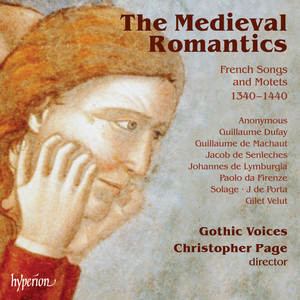
The Medieval Romantics: French Songs & Motets, 1340-1440
- 指挥: Christopher Page
- 乐团: Gothic Voices
- 发行时间:1991-10-01
- 唱片公司:Hyperion
- 类型:录音室专辑
- 歌曲
- 时长
-
作曲家:Anonymous
-
作品集:Anonymous
-
作曲家:Solage
-
作品集:Solage
-
作曲家:Anonymous
-
作品集:Anonymous
-
作曲家:J. de Porta
-
作品集:J. de Porta
-
作曲家:Guillaume de Machaut
-
作品集:Machaut
-
作曲家:Paolo da Firenze
-
作品集:Paolo da Firenze
-
作曲家:Anonymous
-
作品集:Anonymous
-
作曲家:Guillaume de Machaut
-
作品集:Machaut
-
作曲家:Anonymous
-
作品集:Anonymous
-
作曲家:Jacob de Senleches
-
作品集:Jacob de Senleches
-
作曲家:Guillaume de Machaut
-
作品集:Machaut
-
作曲家:Guillaume Dufay
-
作品集:Dufay
-
作曲家:Gilet Velut
-
作品集:Velut
-
作曲家:Johannes de Lymburgia
-
作品集:Johannes de Lymburgia
简介
《The Medieval Romantics: French Songs & Motets, 1340-1440》由Gothic Voices与Christopher Page联袂呈现,聚焦14至15世纪法国中世纪音乐的诗意与革新。专辑收录Dufay、Machaut等作曲家的世俗歌曲与经文歌,展现中世纪浪漫主义音乐中复调织体与人声的微妙平衡。从宫廷情歌到宗教沉思,作品跨越百年历史,以复调技法勾勒出中世纪晚期音乐的情感张力与结构之美。人声的复调编织与器乐的简约点缀,为现代听众打开了一扇通往中世纪听觉美学的窗口。

